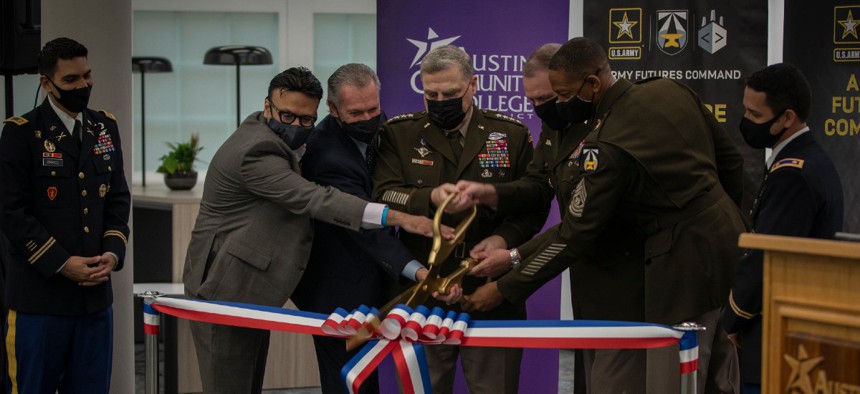How the Army Software Factory Preps Soldiers for Future Battlefields

Army Futures Command conducts am April 15 ribbon-cutting ceremony with Army Gen. Mark Milley to mark a new phase for the Army Software Factory, which now has an official presence within the Austin Community College District’s Rio Grande Campus in Texas. Luke J. Allen/U.S. Army
Program lead Maj. Vito Errico said the project is focused on helping the Army figure out how to organize product teams for the future force.
Last fall during Project Convergence 2020, the Army’s series of exercises for testing Joint All-Domain Command and Control tactics, participants spent weeks coding and re-coding just to make systems work together, according to the commander of Army Futures Command.
“It was a blinding flash of the obvious that if you look at what I think the future battlefield could look like, we're going to have to have the ability to code at the tactical edge,” Gen. John Murray said during a recent Center for New American Security webinar.
Combat units will need soldiers able to rewrite code “at a moment's notice,” Murray said. Enter the Army Software Factory, DOD’s first soldier-led software factory. While the idea for the Army’s first software factory has been circulating for several years, officials participated in an April 15 ribbon-cutting ceremony to unveil the factory’s physical location at the Austin Community College District’s Rio Grande Campus.
Maj. Vito Errico, the lead for the software factory project, told Nextgov the April ceremony also signaled an important milestone for the first cohort of participants in the Software Factory program: The group finished up the introductory period used to arm soldiers with a baseline set of skills and will transition to work on product teams. Nextgov talked with Errico in a recent interview to understand how the program works.
Like most of the DOD software factories, the Army’s version is focused on delivering software through DevSecOps, meaning security is baked right into the incremental development process. The factory aims to quickly deliver baseline capabilities to users and then be able to capture feedback to continue development and meet user needs.
The whole process is undergirded by a continuous authority to operate, which the Army Software Factory leverages through a partnership with the Army’s Enterprise Cloud Management Agency, according to Errico. The software factory is also already engaged in multicloud production in Amazon Web Services and Microsoft Azure clouds through the ECMA partnership, he added.
But what separates the Army Software Factory from others at DOD is its focus on upskilling soldiers and shaping how the Army can organize those servicemembers into product and technology teams for the battlefields of the future. Rather than allowing contractors to take the lead, it’s about soldiers designing for soldiers. And the philosophy behind the Army Software Factory mirrors the agile development process it’s fostering, according to Errico.
“This whole idea is exactly that,” he said. “It's about building tests, and getting feedback, and then rapidly implementing that feedback.”
Lisa Gaisford, government managing director for Dcode, a federal technology accelerator, said the Army Software Factory’s focus on talent development is “fundamentally unique.”
“They're bringing industry in as mentors, not as the developers,” Gaisford said. Dcode met with the first cohort to talk about problem framing and human-centered design.
The focus on soldiers leading soldiers does not mean Army Futures Command views software development as a part-time job, though. Participants in the program won’t rotate through only to get thrown back into the regular Army, Errico said.
Instead, the Army Software Factory is a three-year “full assignment,” Errico said. Every six months, a new cohort of soldiers will join the program and start with what Errico called a tech accelerator to bring everyone up to speed. Soldiers are then aligned with one of three tracks: platform operations, application engineering or product management and design.
After that, soldiers will be placed on product teams to work on existing, crowdsourced Army problems that cover every facet of the service’s business processes and operations, including logistics, personnel management and tactical operations, according to Errico. Those teams will be partnered with industry until, eventually, the soldiers get to a point where they can wean themselves off industry support and take the lead themselves.
The Army has already identified its second cohort of soldiers for the program, which will kick off in July, Errico said. Assignments for the third cohort are being finalized, and that group will get underway in the late December to early January timeframe, he added.
“Nobody built in what we would call billets—ways for soldiers to be assigned to these organizations long term to come up with a self-sustaining way to actually learn what they need to learn and then for the government to take lead,” Errico said of private industry and other DOD components that have also built software factories.
“We're not going for the quick announcement that's not going to have any real enduring value,” he said. “What we're really doing is going for that repeatable model.”
RELATED PODCAST






